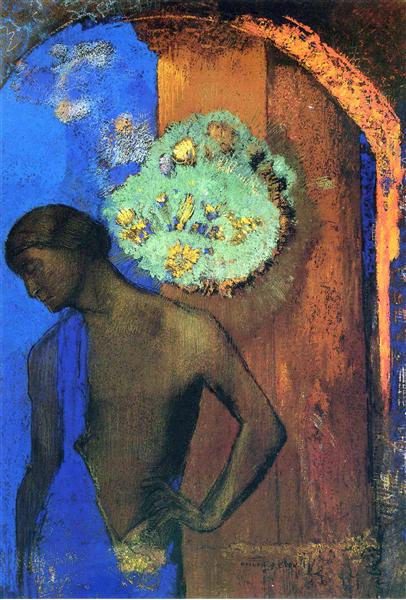Tanım
Odilon Redon's painting "Saint John (The Blue Robe)", painted in 1892, is a work that encapsulates the essence of symbolism and emotional depth that characterize the artist. Known for his unique style that combines the use of color and the exploration of the dreamlike and the spiritual, Redon achieves in this piece an intense evocation of the mysticism associated with the figure of Saint John. The work prominently features Saint John, portrayed in an environment that seems to transcend time and space, where the sacred and the personal are amalgamated.
The composition is notable for its focus on the central figure, who is presented in a robust and contemplative position, wrapped in a blue robe that captures the attention. This masterfully chosen color not only highlights St. John, but also suggests a sense of tranquility and spirituality. Blue, a color that traditionally evokes feelings of calm and peace, can in turn be interpreted as a symbol of heaven and the divine, adding a layer of meaning to the work. In contrast, the background is presented as ethereal and subtle, with softer, more blurred tones that allow the figure of St. John to stand out as a beacon of light in a hazy environment.
St. John's facial features are serene and contemplative, suggesting a deep connection to the spiritual. Redon uses his signature soft brushstrokes to create both the face and the robe, imbuing the image with an almost ethereal quality. St. John's gaze seems to be directed toward the viewer, establishing a connection that invites reflection and wonder. In Redon's method, the human figure is transformed into a channel for the exploration of more abstract themes, such as the search for truth and spiritual revelation.
Symbolism in Redon’s work is vital. Despite being a portrait of a saint, the focus is less on direct religious narrative and more on the emotional experience that this figure represents. It is possible that Redon was seeking to represent not just the apostle, but the ideal of the spiritual seeker who transcends words and traditions. This approach resonates with the time in which Redon was working, a period when many artists were challenging convention and exploring new forms of expression that communicated deeper emotions and moods.
Delving into the context of the work, it is essential to consider that Redon aligns himself with the symbolist movement, which emphasizes subjective experience and the predominance of dreams over reality. Like other artists of his time, such as Gustave Moreau and Paul Gauguin, Redon seeks poetry in the visual, transforming the ordinary into something extraordinary and evocative. His ability to capture the intangible, the dark and the luminous in a single image, is one of the aspects that distinguishes him as a pioneer in modern painting.
"Saint John (The Blue Tunic)" is not just a representation of a religious figure, but an exploration of the human condition in the face of the divine. The fusion of color and form, the carefully orchestrated composition, and the use of symbolism make this work a significant piece not only in Redon's oeuvre, but in the history of art as a whole. As an authentic testimony of a journey towards the sublime, it invites viewers to immerse themselves in its contemplation and experience the dialogue between existence and the transcendental, a dialogue that Redon manages to express masterfully through his art.
KUADROS ©, a famous painting on your wall.
Hand-made oil painting reproductions, with the quality of professional artists and the distinctive seal of KUADROS ©.
Painting reproduction service with satisfaction guarantee. If you are not completely satisfied with the replica of your painting, we will refund 100% of your money.

